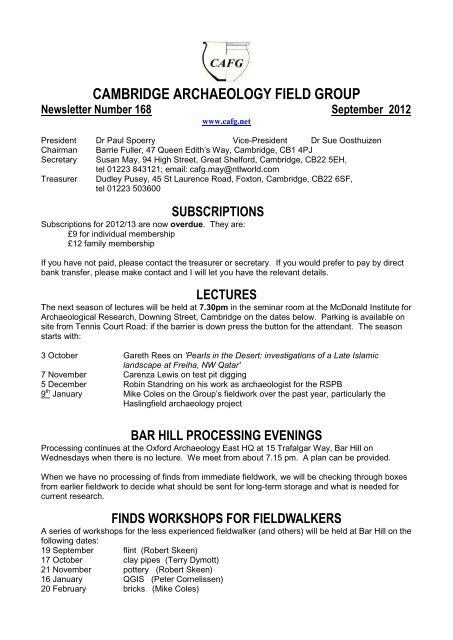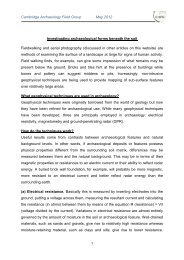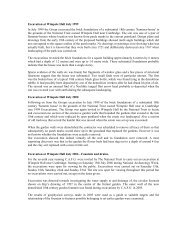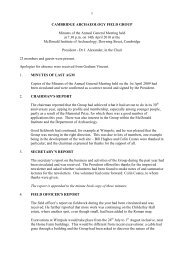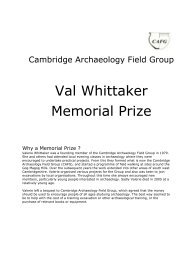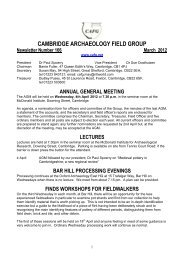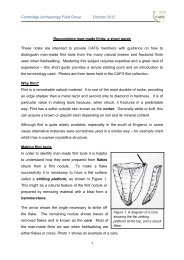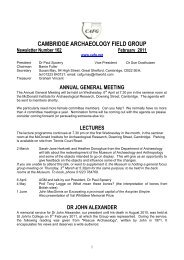CAFG newsletter 168 - Cambridge Archaeology Field Group
CAFG newsletter 168 - Cambridge Archaeology Field Group
CAFG newsletter 168 - Cambridge Archaeology Field Group
You also want an ePaper? Increase the reach of your titles
YUMPU automatically turns print PDFs into web optimized ePapers that Google loves.
CAMBRIDGE ARCHAEOLOGY FIELD GROUP<br />
Newsletter Number <strong>168</strong> September 2012<br />
www.cafg.net<br />
President Dr Paul Spoerry Vice-President Dr Sue Oosthuizen<br />
Chairman Barrie Fuller, 47 Queen Edith’s Way, <strong>Cambridge</strong>, CB1 4PJ<br />
Secretary Susan May, 94 High Street, Great Shelford, <strong>Cambridge</strong>, CB22 5EH,<br />
tel 01223 843121; email: cafg.may@ntlworld.com<br />
Treasurer Dudley Pusey, 45 St Laurence Road, Foxton, <strong>Cambridge</strong>, CB22 6SF,<br />
tel 01223 503600<br />
SUBSCRIPTIONS<br />
Subscriptions for 2012/13 are now overdue. They are:<br />
£9 for individual membership<br />
£12 family membership<br />
If you have not paid, please contact the treasurer or secretary. If you would prefer to pay by direct<br />
bank transfer, please make contact and I will let you have the relevant details.<br />
LECTURES<br />
The next season of lectures will be held at 7.30pm in the seminar room at the McDonald Institute for<br />
Archaeological Research, Downing Street, <strong>Cambridge</strong> on the dates below. Parking is available on<br />
site from Tennis Court Road: if the barrier is down press the button for the attendant. The season<br />
starts with:<br />
3 October Gareth Rees on 'Pearls in the Desert: investigations of a Late Islamic<br />
landscape at Freiha, NW Qatar'<br />
7 November Carenza Lewis on test pit digging<br />
5 December Robin Standring on his work as archaeologist for the RSPB<br />
9 th January Mike Coles on the <strong>Group</strong>’s fieldwork over the past year, particularly the<br />
Haslingfield archaeology project<br />
BAR HILL PROCESSING EVENINGS<br />
Processing continues at the Oxford <strong>Archaeology</strong> East HQ at 15 Trafalgar Way, Bar Hill on<br />
Wednesdays when there is no lecture. We meet from about 7.15 pm. A plan can be provided.<br />
When we have no processing of finds from immediate fieldwork, we will be checking through boxes<br />
from earlier fieldwork to decide what should be sent for long-term storage and what is needed for<br />
current research.<br />
FINDS WORKSHOPS FOR FIELDWALKERS<br />
A series of workshops for the less experienced fieldwalker (and others) will be held at Bar Hill on the<br />
following dates:<br />
19 September flint (Robert Skeen)<br />
17 October clay pipes (Terry Dymott)<br />
21 November pottery (Robert Skeen)<br />
16 January QGIS (Peter Cornelissen)<br />
20 February bricks (Mike Coles)
FIELDWORK<br />
<strong>Field</strong>walking: We have several projects in the pipeline.<br />
We have agreed with the farmer at Childerley that we can access any part of his estate, depending<br />
on crops. We are therefore watching progress on harvesting and hoping for rain to wash the sites<br />
down. We have also agreed in principle to walk fields at <strong>Cambridge</strong> Road Farm, Wimpole – there is<br />
19 th century evidence of Roman finds being made here. This will be included in the HLF Grant<br />
application activity if we are successful but will be walked even if the grant does not come through.<br />
Meanwhile, a possible one-off project at Sawtry, at an interesting site with reported Roman and<br />
Medieval finds, is being investigated.<br />
Other potential projects are at Wrestlingworth and farms to the east of <strong>Cambridge</strong>. Clearly we will<br />
not complete all of these and some we may not start until next year, and of course it is all weather<br />
dependent.<br />
Excavation: At the request of Angus Wainwright, NT, we hope to dig, probably in October, a test<br />
trench across geophysics features in the field to the north of Cobb's Wood, Wimpole. This would be<br />
over a weekend and would try to establish the state of preservation of the features, recover some<br />
dating evidence and establish what the geophysics had detected. Members of <strong>CAFG</strong> might be able<br />
to do some metal detecting on this site.<br />
Emails will be sent as soon as plans are finalised.<br />
HASLINGFIELD ARCHAEOLOGY PROJECT<br />
Thanks to all who took part in the test pitting weekend. Our grateful thanks also to Jigsaw Cambs<br />
for their support and CBA East and the Haslingfield Village Society for grants towards the project. If<br />
you have photographs of your pit that you have not sent in, could you please send them to:<br />
michael@coles741.freeserve.co.uk<br />
Paul Blinkhorn has looked at the finds from the test pits and from fieldwalking that we have carried<br />
out in various parts of the parish over the years and has sent his technical report to Rob Atkins.<br />
<strong>Field</strong>walking has produced pottery from the Bronze Age to modern periods, with particularly intense<br />
Roman activity; and recent developer-led archaeology identified significant Iron Age settlement.<br />
The test pits produced Roman, Medieval and post-Medieval pottery, and one sherd of early-middle<br />
Saxon date on the north side of the village.<br />
The preliminary findings suggest that the village formed around a large green in the 10 th /11 th<br />
centuries, possibly moving south from an earlier Saxon settlement, but much more work has to be<br />
done on what the pottery tells us about the development of the village. We plan to hold an event for<br />
the village in the New Year and Mike will talk to the <strong>Group</strong> about it in January.<br />
FLINT FROM OILY HALL, LODE<br />
The flint we found fieldwalking at Oily Hall has been given a preliminary assessment by Lawrence<br />
Billington of the <strong>Cambridge</strong> Archaeological Unit, who reports that it contains diagnostic tool types<br />
from the Mesolithic, early and later Neolithic and early Bronze Age periods. We have obtained<br />
grants from the <strong>Cambridge</strong> Antiquarian Society and the National Trust, Wicken, towards a detailed<br />
analysis and are currently approaching the Council for British <strong>Archaeology</strong> for a grant for the<br />
remainder of the cost.<br />
COMMITTEE MEETING<br />
A committee meeting was held on 1 st August, at which time there were 39 paid-up members (8 were<br />
family memberships). We regret to have to announce the death of long serving member Caroline<br />
Sweet and the move from the area of Peter Edwards.
The group has subscribed to CBA East, which now has a separate membership from the national<br />
organization, but we decided against renewing membership of the <strong>Cambridge</strong>shire Association for<br />
Local History as it is involved only peripherally in archaeology. The <strong>Group</strong> has received grants of<br />
£200 from each of the <strong>Cambridge</strong> Antiquarian Society and the National Trust Wicken towards the<br />
full analysis of the flint from Oily Hall, for which we are very grateful, and we are applying to the CBA<br />
for a grant to cover the remaining £230. We have also received £500 from CBA East towards GPS<br />
planning and other expenses of the Haslingfield archaeology project and £50 from the Village<br />
Society towards maps. The pottery was about to be sent to Paul Blinkhorn for dating.<br />
A bid has been made to the Heritage Lottery Fund “All our Stories” fund for a grant to further<br />
research the distribution and history of the various settlements in the parish of Wimpole and we<br />
should know by the end of October whether this has been successful.<br />
We reviewed the application requirements for the Val Whittaker Memorial Prize, taking into account<br />
comments from tutors. We decided not to amend the wording of the form but to try to emphasise to<br />
potential entrants that we are really looking for ownership of original research.<br />
Of the 25 members who responded on proposed amendments to the constitution, only one was<br />
against them. The opportunity will be taken to further review it for the next AGM.<br />
We learnt about suggestions from the Fen Edge <strong>Archaeology</strong> <strong>Group</strong> for collaboration on a local<br />
pottery library and supported the principle of sharing identified types of pot. FEAG were to contact<br />
other archaeology groups in the county to see if there was general support for requesting coordination<br />
by Jigsaw. Also on pottery, we felt that the boxes of pottery at Bar Hill should be checked<br />
over the summer for any finds no longer needed or any collections to be retained for further work as<br />
the County Council planned to deposit most collections in salt mines in Cheshire for long-term<br />
storage.<br />
The Royal Archaeological Institute, as a celebration of the Queen’s Diamond Jubilee, has a section<br />
of their website hosting reports from local societies on their proudest archaeological achievements<br />
of the last 60 years, and we agreed to prepare a short report on the <strong>Group</strong>’s extensive fieldwalking<br />
cover. The best report will be awarded a prize at Current <strong>Archaeology</strong>’s 2013 LIVE!<br />
The website had been visited by 536 people in the previous 3 months, and about 25 members had<br />
registered to view the restricted areas. We would be very glad of any feedback on the website –<br />
Does it have what you want Can you find what you want<br />
If a lecture in memory of Dr John Alexander is to be held, it is likely to be in conjunction with the<br />
<strong>Cambridge</strong> Antiquarian Society autumn conference.<br />
We discussed the fieldwork, lecture and workshop programmes, the results of which appear<br />
elsewhere in the <strong>newsletter</strong>.<br />
We agreed to send out an email with the major points of interest from the committee meeting as<br />
soon as possible afterwards. The next committee meeting is due to be held on the 24 th October,<br />
when any member is welcome to attend.<br />
CONSTITUTION<br />
The amended constitution is available on the website under “About Us”. The whole constitution will<br />
be reviewed over the next few months with a view to presentation at the AGM next April. Members<br />
will have an opportunity to see and comment on the proposals well before the AGM (we hope about<br />
2 months before). One omission is any mention of the role of the committee. If any member has<br />
suggestions for the improvement of the constitution, please let us know.
HERITAGE LOTTERY FUND GRANT BID<br />
As referred to in the notes from the committee meeting, a bid has been submitted for a project<br />
entitled: “Wimpole: Silent voices, deserted homes”. A summary of the proposed project is attached<br />
for those who have not already received it by email, together with a note on accessing the full<br />
document on-line. A paper copy can be read at Bar Hill.<br />
WEBSITE<br />
Peter Cornelissen’s mapping of our more recent fieldwalking finds are on the website, in an area<br />
restricted to <strong>CAFG</strong> members and others specifically authorised. You need to register and obtain a<br />
password, which you can do via the website. You can also access approved committee meeting<br />
minutes by the same system. Please give us you feedback on the website.<br />
VAL WHITTAKER MEMORIAL PRIZE<br />
The award will be presented to Jezz Davies on the 3 rd October for his work on marine archeology.<br />
Jezz was unable to be with us in June.<br />
We have now launched the competition for next year. If you, or anyone you know, are researching<br />
some aspect of archaeology – you need not be studying formally – check the website for details<br />
The closing date for entries is 31 st March 2013.<br />
ARABLE FARMING AND ECONOMY ALONG THE ROMAN FEN-EDGE<br />
On the 7 th March, Dr Rachel Ballantyne outlined what excavations at two sites: Langdale Hale,<br />
Earith and The Camp Ground, Somersham, were revealing about the Roman rural fen-edge<br />
economy. The sites, on dry land promontories below 2m AOD, were near areas of quite dense (for<br />
the fens) rural settlement, with villas on the chalk hills to the South and East and around<br />
Peterborough.<br />
Langdale Hale was possibly a planned farmstead, with post hole structures inside an enclosure and<br />
a separate enclosure with a round house. Quern sizes and long flues rich with cereal chaff<br />
suggested a large scale enterprise. From the period AD50 – 120, a third of the grain was barley,<br />
generally more common on Iron Age sites and then in the late Roman period, and bread wheat was<br />
also present, an unusual find at this time. Other remains were of garden peas (an Iron Age<br />
introduction), flax, reeds (not common other than on fen edge sites), Celtic beans, hazelnuts and<br />
unusual spelt wheat chaff of a type only seen locally. Only the south of the site was rich in chaff,<br />
and burnt debris only abundant in the north.<br />
Use of the site from AD 180 – 325 was more intense, with the chaff rich area spreading from the<br />
post structure and three areas where burnt and unburnt remains overlapped. Styluses and lead<br />
“weights” were found in the south western enclosure, possibly a “show-off” area.<br />
The Camp Ground may have been an inland port from AD 50/70, with incredibly dense Roman<br />
settlement and Iron Age beneath. From the period AD 50/70 - 120 there was sporadic charred<br />
waste from spelt wheat processing, far less than at Langdale Hale. Barley was fairly abundant but<br />
also continued into the later phases, whereas bread wheat was not present until after AD325.<br />
There were garden peas, flax, Celtic bean, hazelnuts, beetroot (1 seed – a Roman introduction),<br />
common club-rush and reeds. Wetland plants were more common than at Langdale Hale.<br />
From the period AD 180 – 325 there were 2 quite large areas of chaff and 1 grain rich area, with<br />
burnt/unburnt remains overlapping, all west of a central ditch or track. The east of the site may have<br />
been for processing/storage and the west for living.<br />
The Camp Ground contained a diverse range of plants and activities, whereas Langdale Hale had a<br />
narrower range, chaff waste being by far the largest proportion of remains. Both had comparable<br />
arable weed seeds and the same unusual spelt wheat chaff, prompting the question whether the<br />
crops being processed at both sites were from the same fields. Langdale Hale was likely to have
een a farm with surplus crop to be processed, whereas The Common Ground showed elements of<br />
craft production and the movement of goods, although with a small amount of grain production.<br />
These sites would fit well with the 10 kilometre market centre catchment area proposed by Hingley.<br />
MEDIEVAL POTTERY IN CAMBRIDGESHIRE: A NEW REGIONAL<br />
REVIEW<br />
Following the AGM on the 4 th April, Dr Paul Spoerry talked about his research project, with others,<br />
on the production and distribution of Medieval pottery in <strong>Cambridge</strong>shire, to be published in East<br />
Anglian <strong>Archaeology</strong>. The resource would probably be managed through Oxford <strong>Archaeology</strong> East<br />
and eventually be on-line. He was not republishing what was already known, but just updating and<br />
recording new types identified. The last 20 years had produced evidence of Medieval pot<br />
production in <strong>Cambridge</strong>shire, from West Colne in the early 1990s and Ely in the mid 1990s. The<br />
current work should provide a common database which all archaeologists in the region could use.<br />
Paul was looking at domestic pottery from the period AD 650 to about 1500. Earlier Saxon pottery<br />
was mostly funerary. Pots were made at home, but also transported considerable distances – it<br />
was heavy and fragile so had to be worth moving, so road and water links were vital. Over time<br />
there appeared to be a shift from very local hand-made pot, to imports from other regions, to fairly<br />
wide-spread regional production. The study area was <strong>Cambridge</strong>shire, Peterborough and the<br />
Norfolk fens, divided into six zones.<br />
In the middle Saxon period, AD650 – 850/875, distribution was mostly by the remains of the<br />
Roman road system, although some assumptions have to be made about what was still there.<br />
Ermine Street ran north-south and the Icknield Way, running north east – south west had been<br />
Romanised and is known to have been sustained, though the Fen Causeway had gone. The<br />
<strong>Cambridge</strong>shire dykes were erected during the strife between the Anglo-Saxons and the<br />
Romanised Britons in the C5/C6 and were still there in the C7. The fen area was not absorbed into<br />
the larger kingdoms and was useful as a buffer zone, besides being difficult to get to.<br />
Hand made pot is found in the north west and south east of the region, always including igneous<br />
rock only found in Mount Sorrel in Leicestershire but which was picked up by the boulder clay - this<br />
rock could have been used as temper or simply occur in the clay. It is not found so much in East<br />
Anglia so may be a Mercian tradition. Ipswich pottery was like that of the low countries and was<br />
distributed all over East Anglia in the C8, often via coastal ports, but little further. Midlands types<br />
are found in the west of the region, but Ipswich ware is found at Ely, the Royal centre of the East<br />
Anglian crown. This suggests that some of the differences in distribution were for geopolitical<br />
reasons.<br />
In the late Saxon period, Roman roads were still significant and the road to Ely still existed,<br />
although the dykes had gone. The region was on the edge of the Danelaw. Monastic landlords<br />
started making waterways in the fens and river systems began to change, such as the shortening of<br />
meanders and the diversion of rivers to Wisbech. Some changes were natural, some man-made.<br />
There were 3 main types of pottery. Stamford ware (only made there) came down the Great North<br />
Road and was used for everything in Peterborough. It was smooth and glazed; the only glazed<br />
pottery of that period; possibly introduced by the Danes from Denmark and France. The shelly St<br />
Neots type pottery, wheelmade but fired simply, was made over a wide area both in the Great Ouse<br />
region and Northamptonshire. Thetford ware was made in the burghs of Thetford, Ipswich and<br />
Norwich and later in rural areas in Norfolk, and was likely to have been distributed overland. Quite a<br />
lot is found in <strong>Cambridge</strong>shire and C10 wasters of a local Thetford ware have been found in<br />
Huntingdon.<br />
In the early Medieval period, c.1050 – 1200, dozens of new waterways were formed, part manmade,<br />
part natural. The Ouse, the Cam and the Nene were linked, canals were dug at Chatteris and<br />
March and nearly all rivers flowed out at Lynn, while Wisbech was silting up. Heavy cheap things<br />
could be moved easily by water while roads were largely seasonal routes. Ely ware starts in this
period but was not sent elsewhere. The region was filling up with locally made pottery: Thetford<br />
ware; hand made pot from Essex.; smooth sandy ware in the south east of the county (<strong>Cambridge</strong><br />
and Burwell); grog tempered pot in South <strong>Cambridge</strong>shire; sandy wares in the south west, around<br />
Potton; developed St Neots ware; and Peterborough was starting to produce its own local ware.<br />
In the high Medieval period, 1200 – 1350, more roads were established, although some are<br />
conjectural. The key production areas in the region were at Ely; the south east fenland at Soham (a<br />
sandy fabric, lighter than Ely); sandy ware in west <strong>Cambridge</strong>shire at Bourn and Caxton; Everton;<br />
Colne; the Huntingdonshire fens (sandy) and shelly wares in Peterborough. So pottery was being<br />
made all over but Ely was probably the only large scale producer. In general the pot did not travel<br />
far, but south east sandy wares travelled east from Soham to Bury St Edmunds and a few other<br />
places close by. Ely wares were distributed by river, using the Cam and Ouse travelling<br />
downstream, now a major trade route, to Lynn until about 1250, when Grimston ware began to be<br />
distributed southwards and upstream via the fenland waterways. The Fenland islands were<br />
dominated by south Lincolnshire pot, coming in via the Nene and the cut through March, but pot<br />
from Northamptonshire came overland to Yaxley and then by river into the fen areas.<br />
In the late Medieval period there was one new river and the Old North Road was replaced by the<br />
Great North Road. There were fewer local producers of pottery – in the region there were potters at<br />
Ely, some in Huntingdonshire and some at Colne; none of the pottery travelled far. Pottery came<br />
into the region from Bedfordshire and Northamptonshire either by road or upstream along the Ouse,<br />
and some came from London round the coast to Lynn.<br />
The aim of the survey, once different types and sources of pottery had been identified, was to try to<br />
work out what was influencing the pot makers and distributors. Was it the geopolitical situation, or<br />
was it an opportunity in a market economy How were they thinking How were they acting Paul<br />
was trying to offer answers to some of these questions, but was well aware that his suggestions<br />
would be superseded in time.<br />
GOBEKLI TEPE: MORE QUESTIONS THAN ANSWERS<br />
On 6 th June Patricia Duff told us about this 11,500 year old stone circle site in Anatolia (southern<br />
Turkey), the area of the earliest villages and domestication of crops. A man-made mound covering<br />
9 ha where people had covered what had previously been built and built again on top, was first<br />
discovered by Americans. In 1995 Prof Smit of Germany realized that there were massive<br />
structures, monumental stone pillars and walls of the 10 th millennium BC, before villages. Further<br />
out were structures of the 9 th millennium. At least ten massive (the biggest was 25m in diameter)<br />
stone circles were found, of about 9,500 BC, but no evidence of settlement. There are possibly<br />
another 10 circles. The earlier pillars were up to 5m high, but the more recent were 3.5m and the<br />
“enclosures” more rectangular. It seemed that one circle was closed and another built. One, known<br />
as Circle C, took about 500 cu.m. of earth to fill – it was later re-excavated and the statues smashed<br />
and carvings on the pillars defaced.<br />
It seems that the walls of the circles were plastered over, but not known whether the walls or the<br />
pillars came first. The pillars were generally T shaped with carvings only on the front and left. The<br />
carvings were of animals – bear, boar, bull, vulture, scorpion, snake, fox, multi-legged insect, but<br />
only one human – a headless man with a possible belt buckle. Where gender was shown it was<br />
male. All the animals were represented in each circle, but only dangerous animals, no gazelles.<br />
Statues had a conical base which would have fitted into a hole in the wall. There were some lifesized<br />
heads, echoing plaster heads at Jericho and elsewhere, possibly related to ancestor worship.<br />
The fill was full of flint chips, obsidian and bone – gazelle and auroch but also healthy human bone,<br />
so possibly the remains of some ritual for the dead. A basin has also been found and the team<br />
were working on it, hoping to find signs of the earliest brewing of beer. No tools were found. The<br />
second phase had pottery.<br />
The site has provoked debate about its purpose. It was already quite high above the Mesopotamian<br />
plain and may have been a trading point. The obsidian found came from 4 sources, including<br />
Capodocia, 400 kls away.
A similar site dated to the second phase of Gobekli Tepe had been found about 50 kl to the north.<br />
This had smaller pillars but 500 figurines, 8-24 cm high, which were not present at Gobekli Tepe.<br />
There were also a further six similar but later sites within 200 kls<br />
JIGSAW CAMBRIDGESHIRE<br />
We are now affiliated to JIGSAW, the new project supporting and developing community<br />
archaeology in <strong>Cambridge</strong>shire. Training workshops are now being organised, for which individual<br />
application should be made. The website is: www.jigsawcambs.org and you are urged to keep<br />
checking it for new events.<br />
CAMBRIDGE ANTIQUARIAN SOCIETY<br />
CAS lecture meetings are on Mondays at 6.00pm at the Law Faculty, West Road, <strong>Cambridge</strong><br />
(except 5 th November), which members of the <strong>Group</strong> are welcome to attend. The season begins<br />
with:<br />
1 October Dr Elizabeth Ashman Rowe on Old Norse Traditions: Ivar the Boneless and Edmund<br />
of East Anglia<br />
5 November Prof Nicholas Thomas & Imogen Gunn on ‘Transforming the Museum: a talk about<br />
the redevelopment and new displays at the Museum of <strong>Archaeology</strong> and<br />
Anthropology', followed by a reception (this meeting will be held at the Museum of<br />
<strong>Archaeology</strong> and Anthropology and will end at 7.30pm)<br />
3 December Prof Norman Hammond on Early Maya Household Economy, Society and Culture at<br />
Cuello, Belize<br />
7 January Dr Christopher Chippindale on Ancient violence: pictures of wars and warriors in the<br />
prehistoric rock-art of Aboriginal Australia and Alpine Europe<br />
26 January (Saturday evening) Dinner and Library tour at Corpus Christi College, <strong>Cambridge</strong><br />
(Details to be circulated)<br />
The autumn conference on recent archaeological work in the county will be held on 24 th November<br />
at the Law Faculty.<br />
LOCAL EVENTS<br />
22 September Castle Hill open day, 12 – 5pm. The full programme of events will be available shortly<br />
on: www.kettlesyard.co.uk/openday , but includes a talk by Alison Dickens of CAU on<br />
Roman <strong>Cambridge</strong> and tours of the area and the Castle mound with Allan Brigham<br />
26 October Guided walk of Reach “Making a living in the medieval fens”. 10am at Fair Green,<br />
Reach. Free but pre-book at www.cam.ac.uk/festivalofideas or phone 01223 766766<br />
27 October The Olympics: now and then talk, 3.30pm Room LG 18, Faculty of Law, <strong>Cambridge</strong><br />
Girton College antiquities museum open 10am – 12noon, 2 – 4pm<br />
Prehistory day, <strong>Cambridge</strong> Archaeological Unit, Storey’s Way, <strong>Cambridge</strong>, 10.30am<br />
– 4pm. Drop in.<br />
30 Oct – 3 Nov Object Stories Museum of <strong>Archaeology</strong> and Anthropology, Downing Street,<br />
<strong>Cambridge</strong>, 10.30am – 4.30pm. Drop in.<br />
3 November Ely Museum finds identification day, 10.30 – 1pm<br />
4 November The life of prehistoric artefacts McDonald Institute, Downing Street, <strong>Cambridge</strong>. 2 –<br />
3.30pm. Hands on. Pre-book, tel: 07712651312, email: ec484@cam.ac.uk<br />
LANDSCAPE AND LOCAL HISTORY GROUP<br />
This group, which exists to support researchers, meets at Anglia Ruskin University, east Road,<br />
<strong>Cambridge</strong> at 7.30pm. Its next meetings are:<br />
27 September David Cozens on The fate of the Ramsey Abbey estates<br />
4 December Dr Ken Sneath on Godmanchester, a celebration of 800 years!
If you are interested, contact Lyn Boothman at annys@boothman27.fsnet.co.uk or phone 01223<br />
323042<br />
CONFERENCES/COURSES<br />
Weekend courses at Madingley Hall (see www.ice.cam.ac.uk for details):<br />
19-21 October Medieval Fenland<br />
23-25 November Villages and their fields<br />
Did the Romans wear false teeth<br />
25-27 January In vino veritas: the history and archaeology of wine<br />
Madingley Hall short courses of 2 hours per week for 5 weeks start again in January with:<br />
Historic environment: seminar group. Starts 8 January<br />
Humps, bumps, buildings and hedges: walking through history. Starts 20 February<br />
22 October Objects and Landscape: how PAS data has been used to advance knowledge and<br />
understanding of the medieval landscape. British Museum. Cost £10. Contact Claire<br />
Costin on ccostin@thebritishmuseum.ac.uk<br />
13-14 October 2012 and 1-2 December 2012 Human remains workshop at Stockwood<br />
Discovery Centre, Luton. See: www.osteologycourses.co.uk<br />
EXCAVATIONS<br />
For details of excavations, go to: www.britarch.ac.ukk/briefing (Council for British <strong>Archaeology</strong>) and<br />
www.digs.archaeology.co.uk (Current <strong>Archaeology</strong>).<br />
NEWS<br />
In case you did not hear: at the excavation of an Anglo-Saxon cemetery in Oakington, a unique joint<br />
burial of a cow and a woman has been found. The woman, who died around AD500, was also<br />
buried with brooches, beads and a keychain.<br />
A previously unknown Iron Age enclosure and Roman villa was uncovered last year at Itter<br />
Crescent, just north of Peterborough<br />
EXHIBITIONS<br />
British Museum: Shakespeare: staging the world until 25 November<br />
LIBRARY ADDITIONS<br />
British <strong>Archaeology</strong> July/August and September/October 2012,<br />
CBA <strong>newsletter</strong> Summer 2012<br />
The Conduit No. 50 (Sept 2012 – Aug 2013). <strong>Cambridge</strong> Antiquarian Society publication of<br />
archaeology/history societies, museums, courses etc. It should also be online shortly at:<br />
www.camantsoc.org<br />
Susan May, Secretary


